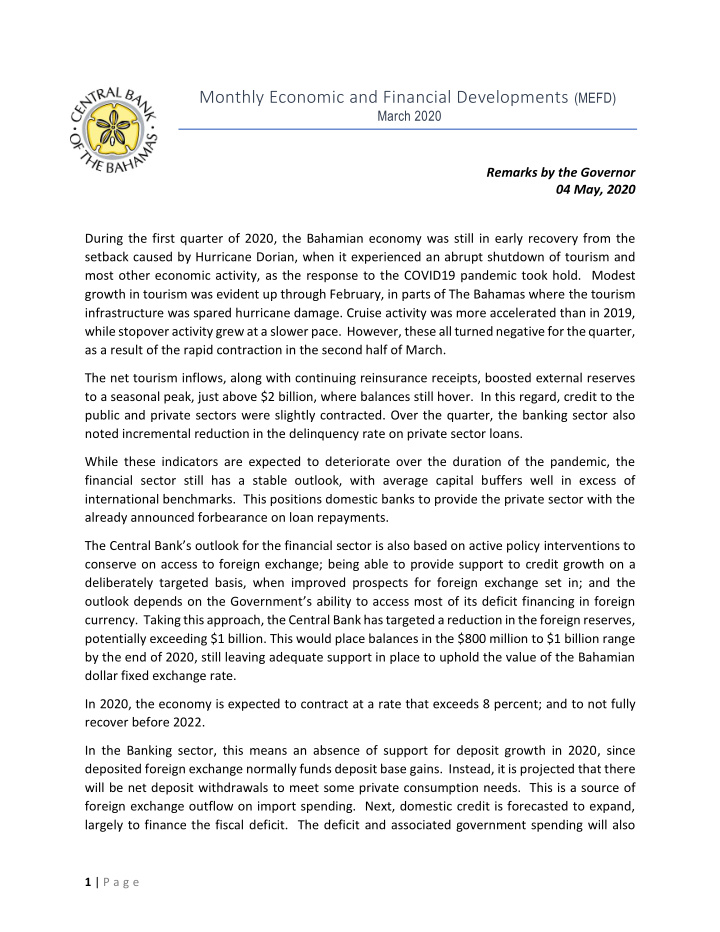



Monthly Economic and Financial Developments (MEFD) March 2020 Remarks by the Governor 04 May, 2020 During the first quarter of 2020, the Bahamian economy was still in early recovery from the setback caused by Hurricane Dorian, when it experienced an abrupt shutdown of tourism and most other economic activity, as the response to the COVID19 pandemic took hold. Modest growth in tourism was evident up through February, in parts of The Bahamas where the tourism infrastructure was spared hurricane damage. Cruise activity was more accelerated than in 2019, while stopover activity grew at a slower pace. However, these all turned negative for the quarter, as a result of the rapid contraction in the second half of March. The net tourism inflows, along with continuing reinsurance receipts, boosted external reserves to a seasonal peak, just above $2 billion, where balances still hover. In this regard, credit to the public and private sectors were slightly contracted. Over the quarter, the banking sector also noted incremental reduction in the delinquency rate on private sector loans. While these indicators are expected to deteriorate over the duration of the pandemic, the financial sector still has a stable outlook, with average capital buffers well in excess of international benchmarks. This positions domestic banks to provide the private sector with the already announced forbearance on loan repayments. The Central Bank’s outlook for the financial sector is also based on active policy interventions to conserve on access to foreign exchange; being able to provide support to credit growth on a deliberately targeted basis, when improved prospects for foreign exchange set in; and the outlook depends on the Government’s ability to access most of its deficit financing in foreign currency. Taking this approach, the Central Bank has targeted a reduction in the foreign reserves, potentially exceeding $1 billion. This would place balances in the $800 million to $1 billion range by the end of 2020, still leaving adequate support in place to uphold the value of the Bahamian dollar fixed exchange rate. In 2020, the economy is expected to contract at a rate that exceeds 8 percent; and to not fully recover before 2022. In the Banking sector, this means an absence of support for deposit growth in 2020, since deposited foreign exchange normally funds deposit base gains. Instead, it is projected that there will be net deposit withdrawals to meet some private consumption needs. This is a source of foreign exchange outflow on import spending. Next, domestic credit is forecasted to expand, largely to finance the fiscal deficit. The deficit and associated government spending will also 1 | P a g e
generate spending on imports. It is the combination of credit growth and deposit base contraction that will cause the net drain on reserves — which is still vital to satisfy essential needs in the population and maintain a measure of economic stability. However, the foreign reserves and protection of the fixed exchange rate are a constraint on The Bahamas. For this reason, the Central Bank’s dialogue with the Government has focused on setting upper limits on how much of the deficit financing can sustainably occur in the domestic markets. The Central Bank has also emphasized, in the context of various advisory bodies, the importance of accelerating other interim access to foreign exchange earnings, such as foreign direct investment; and positioning the economy to recover as safely and swiftly as possible when tourism starts to rebound. The Bank has already taken some direct steps, either to establish priorities foreign exchange or to increase supplies. First, until a recovery is entrenched, resident access to foreign exchange for international capital market investments through Bahamas Depository Receipts and the Investment Currency Market has been suspended. That is, Bahamians are still urged to maintain their investment behaviour and to take advantage of local opportunities until external access is restored. Second, the Central Bank has suspended approval of dividend payments for commercial banks. This has the dual effect of keeping buffers in place for an expected increase in credit losses and halting remittances abroad. Third, commercial banks have been given a more relaxed margin within which to sell foreign exchange to the public, before they are able to draw on the Central Bank’s foreign reserves to make sales to the public. Fourth, in keeping with the principle of viewing the National Insurance Board’s foreign investments as an extended support for the foreign reserves, the Central Bank has requested the NIB to liquidate some of its external investments and bring the proceeds back onshore. The Central Bank is prepared to take additional, broader measures if necessary, to conserve on foreign exchange, and would do so in the near-term rather than later, if the outlook justifies this. If adopted, these measures would target domestic import capacity. While there have been some suggestions that monetary policy could be used to stimulate the economy, this is not an option for The Bahamas. Stimulus through lower interest rates or relaxed credit policies would result in increased consumption on imports, which would undermine the efforts to protect the foreign reserves. The stimulus for the economy needs to be tied to expanded access to foreign exchange. The Government is in a position to do this through its borrowing strategy. As well, in line with the 2016 liberalization measures, the Exchange Control regime allows for a generous subset of 2 | P a g e
private firms to raise financing in foreign currency. The Central Bank is ready to process such proposals and extend approvals as swiftly as they are put forward. To conclude, the economy will operate within more binding foreign exchange constraints in the near- term. However, the tools at the Central Bank’s disposal can protect the foreign reserves, and prioritize access to foreign exchange. Indeed, the economy must maintain currency stability in the interim, until the positive medium-term prospects are within reach. 3 | P a g e
Recommend
More recommend